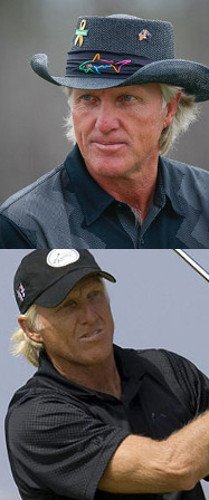
“The Collapse” Turns 20
Even at 61 years of age, Greg Norman remains a stud – a man’s man. He was world number one for what was then a record 331 consecutive weeks. He won the 1986 and 1993 Open Championships. He pounded the driver longer and straighter than anyone before him and most players since. He had a game tailor-made for Augusta National, finishing third the first time he saw the course in 1981. He was tied for the lead going to the 72nd hole at the 1986 Masters before making bogey to lose by a shot to Jack Nicklaus. In 1987, he looked all but assured of winning when Larry Mize holed a 140 foot pitch shot on the dangerous 11th hole in their sudden death playoff. What looked like a course he should dominate had turned into his personal chamber of horrors.
Until 1996 – Norman came in confident and tied the lowest round in Masters’ history with a brilliant 63 on Thursday, giving him a two shot lead over Phil Mickelson’s 65. Norman followed it up with a 69 on Friday to get to 12 under par, giving him a four shot lead over Nick Faldo who opened with a 69 on Thursday followed by a spectacular 67 on Friday. Moving day at the Masters creates drama. Norman started to show some cracks in the armor, but after hitting it into the water on 12, he hit a solid recovery shot from the drop area to make bogey. In fact, he increased his lead after shooting 71, two shots better than Faldo. Going into Sunday’s final round, Norman stood at 13 under par and Faldo, his nearest competitor, was six shots back at -7.
Norman’s troubles started early on an otherwise beautiful Sunday morning. On the driving range, after what he admitted years later was literally a sleepless evening, Norman knew he something was wrong. Butch Harmon, his coach at the time, did as well, but told Norman things looked great in an effort to calm down his star player. Part of his anxiety had to be the identity of the man chasing him. Nick Faldo became only the second player in history to win back-to-back Masters in 1990 and 1991. Where Norman was an emotional, aggressive player, Faldo was methodical, quietly maneuvering his way around a golf course like a modern day Ben Hogan. Besides Faldo’s pressure, Norman’s memory bank was chalk full of the 3rd round leads he failed to convert in 1986 and the shattering loss to Larry Mize nine years earlier.
After driving the ball beautifully all week, Norman hooked his drive on the first hole and made bogey. He made another bogey a few holes later, couldn’t buy a birdie and when he bogeyed the 9th hole, after spinning a wedge off the false front of the green when an easy 9-iron was the shot to play, his six shot lead was down to just two strokes.
They say the Masters tournament begins on the 10th tee on Sunday afternoon. The 10th hole had always given Norman fits and this time it was no different, another bogey. By the time he hit it into the water on 12 again, the lead was gone. Norman had one reasonable chance at coming back with a makeable eagle chip on the 15th hole. He hit a great shot that rimmed the edge of the hole but wouldn’t fall. What did fall was Norman, onto his back in a great show of agony, providing a signature image for one of the greatest collapses in major championship history. Just a few minutes later, Norman’s tee shot at the par-3 16th hole found the water, and the Masters was effectively over.
In the end, Norman shot 78 that day to Faldo’s 67. Faldo turned a six-shot deficit into a five-shot victory and, in a rare moment of emotion, hugged Norman after the round and told him “don’t let the bastards get you down” –knowing full well Norman would fact the gauntlet of the media after signing his scorecard. Norman, to his credit, didn’t make excuses and patiently answered the media questions for a great length of time. He then headed to the airport, boarded his private jet and flew to his home in Florida. He would make one other run at the Green Jacket three years later in 1999, but come up short in much less dramatic fashion to two-time winner Jose Maria Olazabal.





